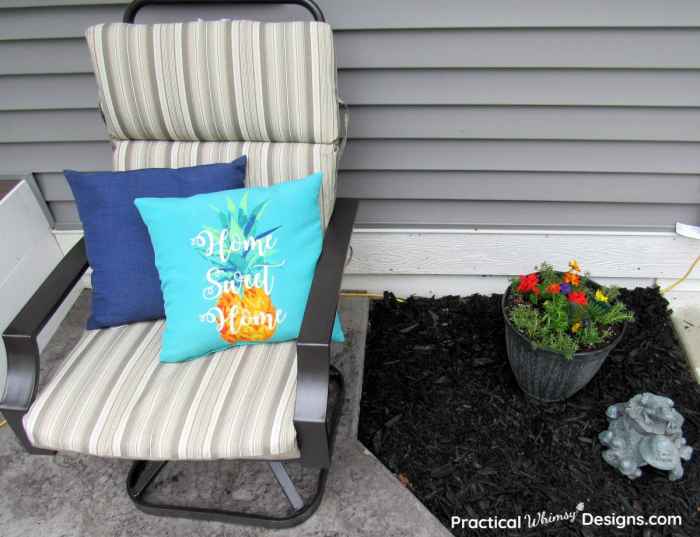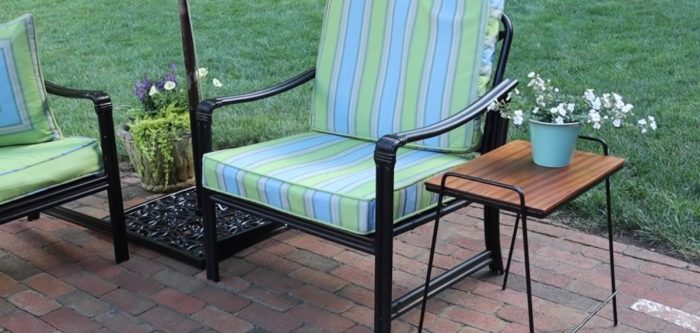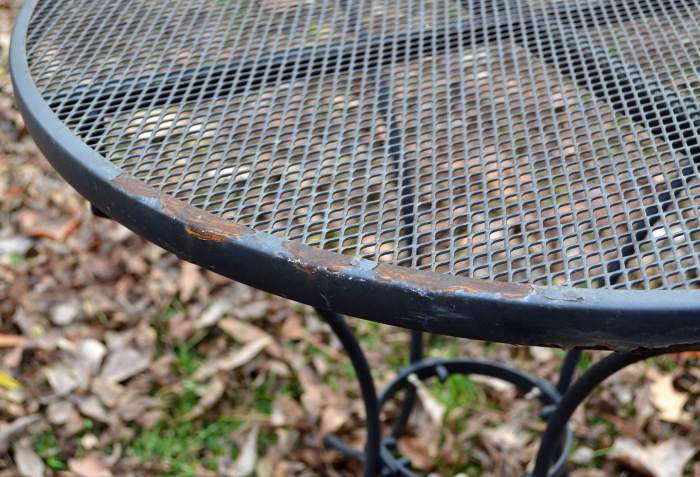Transform your faded and weathered metal patio furniture into a vibrant and inviting outdoor haven with our comprehensive restoration guide. Whether you’re tackling rust, dents, or peeling paint, we’ll empower you with the knowledge and techniques to restore your furniture to its former glory.
Join us as we delve into the essential steps and considerations for restoring metal patio furniture, ensuring years of enjoyment in your outdoor living space.
Before embarking on your restoration journey, gather the necessary materials and prepare your furniture. Understanding the purpose of each material and cleaning technique will lay the foundation for a successful restoration. From removing dirt and rust to repairing common damage, we’ll guide you through every stage, ensuring your furniture is ready for its transformation.
Materials Required
Restoring metal patio furniture requires a range of materials to ensure effective cleaning, protection, and restoration.
These materials serve specific purposes and contribute to the overall success of the restoration process.
Tools
- Wire brush: Removes loose rust and dirt.
- Sandpaper: Smooths surfaces and prepares them for painting.
- Paintbrush or roller: Applies paint or protective coatings.
- Screwdriver or wrench: Disassembles and reassembles furniture components.
Cleaning Agents
- Mild detergent: Cleans dirt and grime without damaging the metal.
- Rust remover: Dissolves and removes rust from metal surfaces.
- Degreaser: Removes grease and oil buildup.
Protective Gear
- Safety glasses: Protects eyes from debris and chemicals.
- Gloves: Protects hands from chemicals and sharp edges.
- Respirator: Prevents inhalation of harmful fumes from cleaning agents and paint.
Preparation and Cleaning
Before applying new finishes to metal patio furniture, thorough preparation and cleaning are crucial to ensure proper adhesion and a lasting finish. This involves removing dirt, rust, and old paint to create a clean and receptive surface.
Cleaning Methods
- Soap and Water: For general cleaning, use a mild dish soap solution and a soft cloth or sponge. Avoid harsh detergents or abrasive cleaners that can damage the metal.
- Pressure Washer: For heavily soiled furniture, a pressure washer can effectively remove dirt and debris. Use a low-pressure setting and keep the nozzle at least 12 inches from the surface to prevent damage.
- Chemical Cleaners: Commercial metal cleaners specifically designed for patio furniture can remove stubborn stains and rust. Follow the manufacturer’s instructions carefully and rinse thoroughly with water.
Repairing Damage
Metal patio furniture can develop various types of damage over time due to factors like exposure to weather elements, improper handling, or accidental impacts. Identifying and repairing these damages promptly is crucial to maintain the furniture’s functionality and aesthetic appeal.
Common types of damage include dents, cracks, and rust holes. Each type requires specific repair techniques and materials to restore the furniture to its original condition.
Dents
Dents are caused by impacts or pressure on the metal surface, resulting in a sunken or deformed area. To repair dents, you can use a rubber mallet and a piece of wood or a dent puller.
- Place the wood or a rubber block over the dent to protect the metal from further damage.
- Gently tap the dent with the rubber mallet, working from the edges towards the center.
- Repeat until the dent is mostly removed. For deeper dents, you may need to use a dent puller, which involves drilling a small hole in the dent and using a suction cup to pull it out.
Cracks
Cracks in metal patio furniture can occur due to stress or excessive force. To repair cracks, you will need a metal epoxy or welding equipment.
- Clean the crack thoroughly with a wire brush or sandpaper.
- Apply metal epoxy to the crack and allow it to cure according to the manufacturer’s instructions.
- For larger cracks, welding may be necessary. This involves using a welding torch to fuse the metal back together.
Rust Holes
Rust holes are caused by corrosion of the metal due to moisture or exposure to salt. To repair rust holes, you will need to remove the rust and patch the hole.
- Use a wire brush or sandpaper to remove all loose rust from the area around the hole.
- Apply a rust-resistant primer to the area.
- Cut a piece of metal that is slightly larger than the hole and place it over the hole.
- Secure the metal patch with rivets or bolts.
Refinishing Options
Choosing the right refinishing option for your metal patio furniture depends on factors such as durability, aesthetics, cost, and the condition of the furniture.
Painting
Painting is a relatively inexpensive and easy way to refinish metal patio furniture. It allows you to customize the color and finish of the furniture to match your style and décor.
Advantages:
- Inexpensive
- Easy to apply
- Wide range of colors and finishes available
Disadvantages:
- Not as durable as other refinishing options
- Can chip or peel over time
- Requires regular maintenance
Application Techniques
Proper application techniques are crucial for ensuring the durability and aesthetics of your refinished metal patio furniture. Surface preparation, application methods, and drying times must be followed meticulously to achieve the best results.
Surface Preparation
Thoroughly clean the furniture using a degreaser and remove any loose paint or rust. Sand the surface with fine-grit sandpaper to create a smooth base for the new finish. Wipe away any dust or debris with a tack cloth.
Application Methods
Apply the new finish in thin, even coats. Use a brush or roller specifically designed for metal surfaces. For spray paint, hold the can 6-8 inches from the surface and apply multiple light coats. Allow each coat to dry completely before applying the next.
Drying Times
Refer to the manufacturer’s instructions for specific drying times. Generally, allow 24-48 hours for the finish to fully cure and harden. Avoid using or exposing the furniture to moisture or extreme temperatures during this time.
Maintenance and Protection
Maintaining your restored metal patio furniture is crucial to extend its lifespan and preserve its beauty. Regular cleaning, touch-ups, and weatherproofing are essential practices to keep your furniture looking its best.
Regular Cleaning
Cleaning your furniture regularly will remove dirt, debris, and grime that can accumulate over time. Use a mild soap solution and a soft cloth to gently wipe down the furniture. Avoid using harsh chemicals or abrasive cleaners, as these can damage the finish.
Rinse the furniture thoroughly with clean water and dry it completely with a clean towel.
Last Word
As you complete your restoration project, remember that maintenance and protection are crucial for preserving the beauty and longevity of your metal patio furniture. Regular cleaning, touch-ups, and weatherproofing will ensure your furniture withstands the elements and remains a cherished part of your outdoor oasis.
By following our comprehensive guide, you’ll restore your metal patio furniture to its former glory, creating a welcoming and stylish outdoor space that invites relaxation and enjoyment for years to come.



